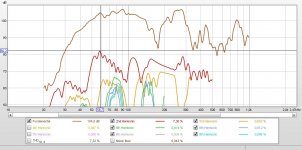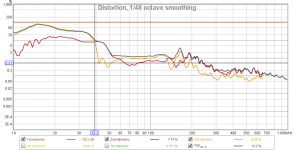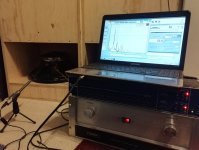Brian, what do you mean by "standard 4th order 6th order BP alignment"?
I assume the response plot you show is from a helmholtz based design and if so then obviously you would see very different acoustic filtering charateristics compared to a qw based design of simillar order.
The question is how much of the messured out of the band noise that stems from the driver direct generated sound and how well the folding deals with the out of band resonant components (higher order harmonics).
In the end what matters is the filtered (processed) response and that would significantly improve the situation, but there will still be higher order harmonics present, the question then becomes is this critical for the perfomance, my take on this is - no it is not, but we are all entiteled to our own opinion.
I assume the response plot you show is from a helmholtz based design and if so then obviously you would see very different acoustic filtering charateristics compared to a qw based design of simillar order.
The question is how much of the messured out of the band noise that stems from the driver direct generated sound and how well the folding deals with the out of band resonant components (higher order harmonics).
In the end what matters is the filtered (processed) response and that would significantly improve the situation, but there will still be higher order harmonics present, the question then becomes is this critical for the perfomance, my take on this is - no it is not, but we are all entiteled to our own opinion.
Brian, what do you mean by "standard 4th order 6th order BP alignment"?
That should have been "standard 4th order or 6th order BP alignment".
I assume the response plot you show is from a helmholtz based design and if so then obviously you would see very different acoustic filtering charateristics compared to a qw based design of simillar order.
Agreed. The BP arrangement will typically provide better filtering, The TH arrangement is supposed to provide greater sensitivity (the penalty being a larger box), a wider passband (though not necessarily a wider *useful* passband) and better driver cooling (with it having its motor situated in the mouth of the design). Undersize a TH however, and basically what you end up with is the acoustic equivalent of a basic bandpass box, with poor filtering of out of band noise. It might be best then at that point to just go with a well-designed 4th or 6th order BP box, unless you're really concerned about dealing with the heat from the driver's motor at high volumes. That said, there are ways of dealing with heat buildup in 6th order BP boxes, if the layout of the box is designed appropriately.
The question is how much of the messured out of the band noise that stems from the driver direct generated sound and how well the folding deals with the out of band resonant components (higher order harmonics).
As both of the published images are measured response curves, I think that your question's already been answered. The acoustic filtering of the TH's path may apply to higher frequencies. However when you get below about 300 Hz, the only way to filter those frequencies out is extensive stuffing (which also kills low frequency performance), or filtering the signal (which unfortunately does not filter the HD amplified by the out of band noise). In comparision, for the example that I gave, the combination of vent sizes and lengths and driver position in the box resulted in significant nulling of the first out of band resonance peak, resulting in a bandpass box that could theoretically be used with no active filtering at all, as the out of band noise is significantly below the level of the passband, and the HD is reduced as well as the acoustic filter is now more effective.
So what Helmholtz design is this that you are referring to and where can I learn more about it (size, driver compliment, performance).
Regarding your opening statement:
The comparison is interesting, don't get me wrong, but the if your main concern is the out of band noise then simply build a Helmholtz based band pass since not much else will beat it in that particular regard.
Regarding your opening statement:
If I where to design a higher order Helmholtz based (ported) band pass enclosure I would be surprised (to say the least) of seeing a out of band response like that of QW based design such as the THAM15 seeing as the acoustic filtering part of a Helmhotz design is not even present in that case, or in any case regarding TH's, this is a given, so I fail to see the value of that statement, or am I missing something?If I saw curves like that from a standard 4th order 6th order BP alignment that I was trying to put together, I'd toss the design and go back to the drawing board to come up with something better (like the attached, which shows a lot less out of band noise).
The comparison is interesting, don't get me wrong, but the if your main concern is the out of band noise then simply build a Helmholtz based band pass since not much else will beat it in that particular regard.
When aiming for the same response in useful bandwith, parrallel BP 6th vs TH (and their variants) is just a matter of compromise, between filtering vs headroom, depending of segment/port size/lengh, affecting chuffing/port compression/resonnance.
Relevance depend mostly of max level needed/wanted, and taste .
.
We often get wrong trying to argue scientifically the second part, and so esoterically.
Relevance depend mostly of max level needed/wanted, and taste
We often get wrong trying to argue scientifically the second part, and so esoterically.

Last edited:
If you hear different character from same response curve, get the level down until distortion is gone. For TH, you'll have to lower more level than bandpass wich filter acoustically it distortion product (when done as Brian suggest).
I don't expect any character sound from a sub/low way. If i want harmonics, i want the same distribution from the full system bandwith. It's preamp's job. I say "I". It's still a matter of taste and compromises.
I find you choice hard to implement in a multi-way system. This makes harmonics distribution totally uncoherent at crossover frequency. It add a artificial layer of character independently of the recording instrument character. We can imagine lower notes on a bass recordered with a modern active bass tone (let say a dingwall bass), and higher notes with a fender p-bass tone. Not something i would apreciate.
Powerfull FIR equing with same reponse curve (phase included) make all low range speakers sound the same at level where distortion is not a problem. Things become different for mid/high-range where directivity make things too awfully complicated. Not something i'm ready to deal with for the moment.
I don't expect any character sound from a sub/low way. If i want harmonics, i want the same distribution from the full system bandwith. It's preamp's job. I say "I". It's still a matter of taste and compromises.
I find you choice hard to implement in a multi-way system. This makes harmonics distribution totally uncoherent at crossover frequency. It add a artificial layer of character independently of the recording instrument character. We can imagine lower notes on a bass recordered with a modern active bass tone (let say a dingwall bass), and higher notes with a fender p-bass tone. Not something i would apreciate.
Powerfull FIR equing with same reponse curve (phase included) make all low range speakers sound the same at level where distortion is not a problem. Things become different for mid/high-range where directivity make things too awfully complicated. Not something i'm ready to deal with for the moment.
Last edited:
So what Helmholtz design is this that you are referring to and where can I learn more about it (size, driver compliment, performance).
It's my "Enigma" build. Part of it is documented here, but there have been a few adjustments done afterwards that have not been documented (e.g. driver change). The Subwoofer DIY Page - Projects : An INF10 Bandpass Subwoofer
Theoretically it can be scaled up for a 15" solution, but I really haven't had time to investigate that further.
Regarding your opening statement:
If I where to design a higher order Helmholtz based (ported) band pass enclosure I would be surprised (to say the least) of seeing a out of band response like that of QW based design such as the THAM15 seeing as the acoustic filtering part of a Helmhotz design is not even present in that case, or in any case regarding TH's, this is a given, so I fail to see the value of that statement, or am I missing something?
THs are basically series-tuned 6th order BP designs taken to their logical limits. The out of band noise is a function of the mouth size as well as the location of the drivers within the path that's folded up into a box. Is basically the same story with "basic" bandpass designs - something I ran into when rebuilding the "Enigma". With that knowledge, theoretically you can adjust vent size, length and driver location to manipulate the magnitude and location of that out of band noise.
A Helmholtz-resonator port will have mainly odd order harmonics and does sound quite different to quarter wave resonators that tend to have mainly even order harmonics.
Theoretically, the acoustic filtering effect of a bandpass design actually works better on the odd order harmonics as they are further out of the passband. There's the THD of my 4th order BP Enigma driven up to the THD=10% in the passband level. Distortion is basically kept at a very low level until just above 50 Hz, where it starts increasing until it hits 10% at 40 Hz. This increase is primarily even order (2nd harmonic). Odd-order harmonics (3rd order here) are actually suppressed, then rocket up as the frequency is lowered to 40 Hz. Below that the odd-order harmonic is greater, but that's because driver excursion is being exceeded and the distortion-damping effect of the acoustic bandpass is being exceeded as well (the harmonics now fall within the passband, rather than out of it).
Above 50 Hz, odd-order harmonics are higher (1% vs. 0.5%), but the overall THD level at that point really is too low for anyone to really hear a difference, particularly if this sub is used as part of a full range system. I suspect that distortion is primarily a function of vent characteristics, e.g. different termination at each side of the vents.
They are not interchangable without effecting the sound character.
That's the curious one to me, as I always hear that bandpass alignments "don't sound good" or "don't have punch". I suspect difference in "sound character" is more to do with the radiating area of the bandpass (all of the sound is through the vents) rather than THD, the latter of which should be better with a BP alignment.
Attachments
If you hear different character from same response curve, get the level down until distortion is gone.
Theoretically, yes
I suspect that the radiating area makes a difference, but that's just speculation on my part at this point.
Trying to argue for the sexy contender is humanTheoretically, yes.
I suspect that the radiating area makes a difference, but that's just speculation on my part at this point.
@Tonskulus - Nice amp! Am I correct in that it has a woodstock-ish feel to it?  thanks for sharing your findings.
thanks for sharing your findings.
Regarding directivity, it is true that a larger coupling area means more of it, altough I'm not sure how large area one needs with regards to frequency, the lower the frequency the more area you need I guess, we did recieve some positive feedback on this when we tested a ROAR12 at a local pro sound company but no measurents were taken so I cannot confirm it.
Regarding directivity, it is true that a larger coupling area means more of it, altough I'm not sure how large area one needs with regards to frequency, the lower the frequency the more area you need I guess, we did recieve some positive feedback on this when we tested a ROAR12 at a local pro sound company but no measurents were taken so I cannot confirm it.
There has been some directivity comparsions where tapped horns indeed had more directivity from 60Hz and up, compared to other types. So there has to be something we might not know yet.
But yes, DC300A is the amp I can trust 100%. It does all the things what amplifier should do - no less no more. Reference stuff.
Ok, here is screenshot of distortion pattern. Measured at the mouth.
I'll take impedance measurements soon!

But yes, DC300A is the amp I can trust 100%. It does all the things what amplifier should do - no less no more. Reference stuff.
Ok, here is screenshot of distortion pattern. Measured at the mouth.
I'll take impedance measurements soon!

For a clearer image, select the Plot normalised to fundamental" option, and change the highest harmonic to "3". That will make for easier comparisons.
Also, I do distortion testing at various levels, up to the point that the system hits 10% THD in its passband. This typically means that close-miked testing is out, as the mike could get overloaded.
Also, I do distortion testing at various levels, up to the point that the system hits 10% THD in its passband. This typically means that close-miked testing is out, as the mike could get overloaded.
Baffle step is a big problem with small radiating area with our big boys sub boxes and can give big boost where we don't want it around 300-800hz depending of port size/placement. With huge mouth around the same size of the box, no more problem. Just played with this : Tolvan Data after re-reading a old Hornresp collector post. So TH, Tham and moreover Roar have lot less to deal with diffraction by construction.
Still, if there's no sound produced around those frequencies (distortion product) as with suggested well done fitering bandpass (acoustically), there nothing to be boosted by baffle diffraction .
.
Still, if there's no sound produced around those frequencies (distortion product) as with suggested well done fitering bandpass (acoustically), there nothing to be boosted by baffle diffraction
Last edited:
I've got a stack of 6 Tham's and jesus they are loud when stacked together....[/QUOTE]
A single THAM 15 have enough low extensions? I am asking for DJ all kind of music, and sometimes live music.
What about 4x THAM 15?
What about 6X?
Do you get low extensions also ? Or just kick? Do you need more infra bass along THAM 15?
I am wondering about 38-48 Hz, because now I have 2x 18" BR and I want to try some THAM 12 (maybe 4, maybe 6) or THAM 15... there is no side by side test, and I can't imagine what is the result (in real world).
Best Regards.
A single THAM 15 have enough low extensions? I am asking for DJ all kind of music, and sometimes live music.
What about 4x THAM 15?
What about 6X?
Do you get low extensions also ? Or just kick? Do you need more infra bass along THAM 15?
I am wondering about 38-48 Hz, because now I have 2x 18" BR and I want to try some THAM 12 (maybe 4, maybe 6) or THAM 15... there is no side by side test, and I can't imagine what is the result (in real world).
Best Regards.
- Home
- Loudspeakers
- Subwoofers
- THAM15 - a compact 15" tapped horn


